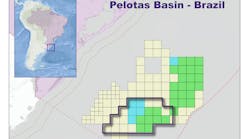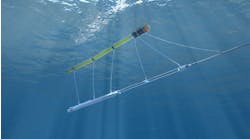New knowledge expands potential plays
Dennis Carlton
Evergreen Resources
Robert Zilinski
Consultant
The exploration targets in the North Falk-land basin changed after the drilling of the first six wells in the basin. The initial wells targeted deltaic sediments above a basin-wide lacustrine source rock. Now the exploration objects are rift related near-shore/fluvial sandstones below the regional lacustrine source rock, which also creates a seal.
The North Falkland basin remained unexplored until the 1990s. The nearest well control was in a separate basin, 450 km west in Argen-tinean waters. Early regional gravity and magnetic data did not have the resolution to define the basin; however, there was a slight indication of a basin on a Halliburton Geophysical Services seismic line that was shot in 1977.
In the late 1970s, published work by Rabinowitz and Labrecque, based upon single channel seismic, showed a northward prograding wedge of Cenozoic sediment off the shelf, suggesting a sediment source near the North Falkland basin area.
Geologically, the basin comprises an older NW-SE trending Jurassic basin with a younger N-S trending Early Cretaceous basin. All of the wells drilled in the basin (circles) have concentrated on the Early Cretaceous basin.
null
The gross boundaries of the basin were defined in 1991 when the HGS data was reprocessed. The reprocessed data was good enough to convince Spectrum to shoot a regional NE-SW and NW-SE, 15-km by 15-km, 2D seismic grid in 1993. Spectrum followed this in 1995 by shooting a N-S and E-W, 5-km by 15-km seismic grid. These two grids were the basis for the first competitive bid round in 1996.
This seismic data defined an older, northwest trending Late Jurassic rift and a younger, N-S trending Early Cret-aceous rift. The Cretaceous rift is 120 km long by 50 km wide and is asymmetrical with the deepest part to the east. A north trending, intrabasinal horst divides the main eastern half graben from the smaller western half graben. After the bid round, all the groups shot additional 2D data on their respective blocks, with Shell shooting a 3D grid on part of their Tranche B.
A six-well drilling program followed the seismic data acquisition in 1998. Shows were seen in most of the wells. Some oil was recovered in both the Shell 14/5-1 well and the Hess 14/9-1 well. Shell also took several major gas kicks near total depth in their 14/5-1 wells with trip gas reaching over 30%. None of these wells tested the rock formations using a drill stem test.
Since no wells drilled were in the basin, the predicted section was derived from seismic data and reg-ional information from the Malvinas and Magellanes basins to the west. Seismic data showed a rift basin with an extensive, southward-prograding delta complex. Because of the marine incursions that occurred during Early Cretaceous time in the Malvinas and Magellanes basins, it was assumed that the same marine trangression entered the North Falkland Island basin. Calculated travel time from the seismic data also suggested that over-pressured marine shale would be encountered.
The first wells drilled in the basin found a non-marine, Late Jurassic to Early Cretaceous syn-rift clastic section overlying the Devonian basement. The basement was encountered in only one well drilled on the intra-basinal horst. A basin-wide, "world-class," organic rich Barremian to Valan-ginian lacustrine source rock overlaid these early syn-rift clastics.
An Aptian age southward prograding delta complex overlies and in part interfingers with the upper part of the lacustrine source rock. A paralic upper Aptian through Cenomanian age, claystone unit with some interbedded sandstones and coals rests above these deltaic sediments. Unconformability above the Cenomanian are Campanian to Paleocene nearshore marine, fine to coarse-grained clastics.
The North Falkland basin.
null
Source rocks
Valanginian-Barremian claystones (Lc2a) are a world-class lacustrine source rock with average total organic carbon (TOC) of 5.6% and maximum values of nearly 10%. The section is thick, homogeneous, and extensive. In the 14/24-1 well, 576 m were encountered. Shell's research lab found this source rock to be one of the richest and most homogeneous source rocks that they have seen worldwide. The main lacustrine shale thickness varies from 88 m on the median ridge to 584 m in the main graben.
In addition, well data also suggests that valid source rocks are present below this main lacustrine unit with TOC values of 2-7% in the Tithonian to Valanginian section. Although most of the attention has focused on the Valanginian-Barr-emian lacustrine source rocks, there is source potential in the older Val-anginian to Tithonian section. The Tithonian to Valanginian section is deeper and hence entered the oil window earlier than the Valanginian-Barremian source rocks.
Seismic data show the continuation of lacustrine/fluvial deposition in the Valanginian to Tithonian in the deeper parts of the basin, south of the 14/5-1 well. One must remember that the original TOC would have been higher in these older and deeper samples prior to going through the oil window. There is some indication that the lacustrine facies can be mapped on the seismic data, suggesting that older lacustrine source rocks are present deeper in the basin.
Thermal maturation
Vitrinite reflectance (VR) data are scattered on the VR depth plots. Some of the spread is related to contamination in the mud system producing low VR values of 0.2-0.3%. Wells with reflectance data suggest that the top of the main phase of oil generation and expulsion (0.9% VR) is at 2,700 m to 2,900 m. However, data plots from Richards and Hillier suggest a possible higher oil window at about 2,400 m, based on the highest VR data.
Geochemical modeling undertaken during this study shows that the lower part of the Valanginian-Barremian lacustrine source rock is mature in the deeper parts of the basin, expelling hydrocarbons from the Late Cretaceous to Recent. Deeper Tithonian to Valanginian syn-rift source rocks entered the oil window early in the basin history and expelled hydrocarbons during the Early to Late Cretaceous. Major amounts of hydrocarbons (73 Bbbl of oil in the main graben and 3.5 Bbbl of oil in the western sub-graben) were generated and migrated from these source rocks.
This early generation and migration of hydrocarbons is expected to fill pore spaces within the reservoir units, reducing the amount of diagenesis and preserving both porosity and permeability. Because of the lateral extent, thickness, and thermal immaturity in the top of the Valanginian-Barremian source rock, the lacustrine shale acts as a vertical seal to migrating hydrocarbons. Hence, without faulting, there are no direct vertical migration pathways from the mature source rock into the Aptian-Albian deltaic reservoir, the initial main reservoir objective.
null
Play concept
All the initial wells tested structural plays concentrating on the Aptian to Albian deltaic sequence and the Albian to Cenomanian fluvial sequence. Secondary early syn-rift clastic objectives were evaluated in only three wells. Two wells were drilled on the intrabasinal ridge with a third drilled on a structurally higher fault block further to the west. Normally, these tests would be good structural high locations to test early syn-rift section; however, the depositional onlap geometry of the Barremian-Valaginian lacustrine shale excludes hydrocarbon migration into these highs. The three wells that were drilled to any significant depth below the lacustrine shale were not drilled in a structurally or stratigraphically optimum position below the sealing lacustrine shale during this initial drilling phase.
Amplitude versus offset (AVO) analysis and modeling suggest that porous sandstone units are present within the basin in both the main and western sub-graben. Reservoir quality sandstones are a concern due to the greater amounts of volcano-clastic debris within the syn-rift sequence. These indicated that porous sandstones should be charged, if located below the main lacustrine shale, because of the massive amount of liquid hydrocarbons generated and expelled. These AVO anomalies are associated with both structural and stratigraphic traps. Within the basin, none of the wells drilled to date were drilled on features with AVO anomalies.
The main plays in the basin are:
- In the down-slope: beach or lacustrine and deltaic sandstones within the main lacustrine source rock
- Syn-rift fluvial clastics below the main lacustrine source rocks in structural or stratigraphic traps
- Brae type fanglomerates interfingering with the lacustrine source rocks
- Early and Late Cretaceous sandstones are prospective in areas where faults have allowed vertical migration into these units.
Authors
For information or references, contact the authors at email: [email protected] or [email protected].







